 |
Here are the various TLR cameras in my collection. TLR stands for twin lens reflex, cameras that show the subject through a viewing lens which is focus-coupled to the taking lens and the image is projected by a mirror onto a viewing screen. TLRs are an iconic style of camera and my collection is slowly expanding. It started with a Photavit Photina, a Halina AI and a few Rolleicords, but now includes several Rolleiflexes and a randon collection of other models.
The Rolleicord series was a simpler and cheaper version of the iconic Rolleiflex range. I like the 'Cords' because they are affordable (compared to the Rolleiflex) and it is a pleasure to see the scene you are photographing on a 6x6 viewfinder (even though the image is mirrored!). Because one tends to hold them at chest or waist level the viewing perspective is also different then what you typically get from standard view and rangefinder cameras. Last but not least there is something very appealing about the square image format. If you want to try medium format photography, this is the type of camera I would recommend.
Other camera types can be found elsewhere:
SLR cameras
non-SLR cameras with focal plane shutters
various folding cameras
Rollei
Rolleicord I Model 1 Art Deco
The first Rolleicord model, the Rolleicord I Model 1 "Art Deco" introduced late 1933, was also one of the most visually stunning with an intricate Art Deco pattern covering the whole camera body, including the wind knobs. Apparently a version with regular leather covering was also produced although I have never been able to find one.
All Rolleicord had their own film advance system and a frame counter, so there was no need to use the red spy window to look at the frame indicators on the rollfilm backing paper. Like most later models, the Art Deco had the focus knob as well as wind knob on the right-hand side of the camera, but the frame counter was on the opposite side. The main drawback of this early model was probably the rather slow viewing lens, which made the focussing screen rather dim.
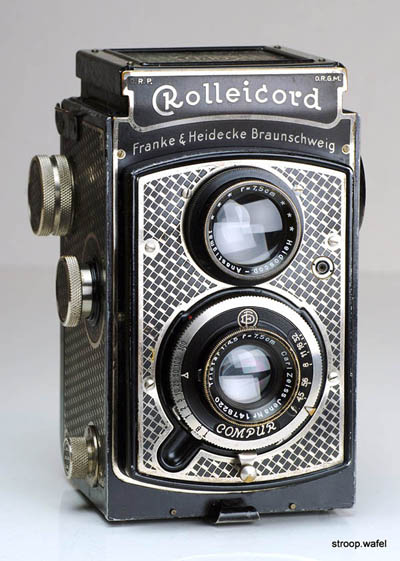 |
|
A 1934 Rolleicord I Art Deco with uncoated CZJ Triotar 75mm f/4.5 lens in a Compur shutter. The Art Deco covering is still in pretty good condition, despite being about 80 years old. This example has a flash sync socket next to the viewing lens, but that is clearly a later modification. |
There appears to be a wide-spread belief on the internet that the Art Deco model had body serial# between 05001 - 37508 while another version with normal leather covering had body # 00001 - 05000. However, a quick search revealed several Art Deco models with serial# <5000. These serial# matched with the lens serial #, which were all lower than 1,465,000, so less than 5,000 from the first Art Deco with lens serial # 1,460,000. Moreover, there appears to be a gap in the lens serial# of the Art Deco between 1,465,000 and 1,470,000. This gap of about 5,000 lenses could very well represent the leather-clad first Rolleicord model, but I have not been able to find a single one of these to prove this. Nevertheless, it would appear that the Art Deco was the first Rolleicord model to be build, not the leather version.
A few Art Deco with much higher lens serial# also exist (ca. 1,600,000 and 1,740,000). These were quite likely build after the Rolleicord I model 2 was introduced in December 1934, as these have lens serial# starting with 1,590,000. So it appears that a few small batches were produced after the main production of the Art Deco, or perhaps these represented old stock that were fitted with newer lenses.
Rolleicord IIe
Changes in the Rolleicord line-up were mostly incremental. From the Art Deco above to the last version of the Rolleicord II, the frame counter moved to the same side as the wind knob and the filter mount changed from a screw mount to a bayonet mount. The focussing screen received a mask for parallax correction. Also, faster taking and viewing lenses were mounted. The wind knob gained a wind lock, so one didn't even need to keep an eye on the counter while advancing the film. The last version, the IIe introduced in 1949, was the first to have coated lenses and had a flash sync socket as standard.
 |
A 1950 Rolleicord IIe with coated CZJ Triotar 75mm f/3.5 lens in a Compur-Rapid shutter. Some paint loss and brassing but in excellent working condition after a good clean, some photo samples can be seen here. |

Side view of the Rolleicord with fully extended lens base for closest focus (2 2/3 feet). Viewing and taking lens moved in unison.
Rolleicord Va
The Rolleicord Va was introduced in 1957 and featured several improvements over the IIe above. It had an interchangeable frame counter which made it very easy to adapt for different frame formats such as 6x4 cm or 35mm film. The focussing screen featured parallax control and in addition it had a frame finder. It featured an improved four-element Xenar taking lens. The shutter had LV markings and aperture and speed scales were coupled. The shutter also had a self timer. A little confusing is that the focussing knob was moved to the opposite side of the camera body. At the back it featured a somewhat hard to interpret exposure guide.
The later Vb was the last Rolleicord to be built and featured an interchangeable focussing screen.
 |
|
A 1957 Rolleicord Va with coated Xenar 75mm f/3.5 lens in a Synchro-Compur shutter. |

Rolleicord Va from different viewpoints. Note that the focus knob is on the left. The frame counter was replaced with an interchangeable version that could be swapped when using masks for different film frame formats (on the same 120 film).
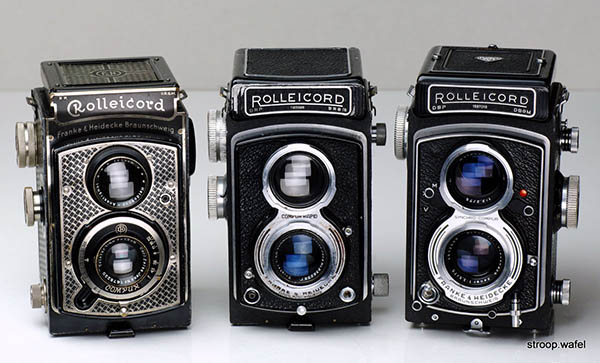
Rolleicord I Art Deco, IIe and Va next to each other. Although they gained more bells and whistles, the basic concept of the later models was very much the same as that of the very first model.
Rolleiflex Original
The Rolleiflex was first introduced in 1929 (before the Rolleicord) and it caused quite a stir. At the time, 35mm cameras were still in their infancy and so were rangefinders. The most common cameras were folding and box cameras, neither of which had great viewfinders, so framing and focussing were not that accurate. Of course there were plate cameras but these were large and cumbersome. The Rolleiflex allowed accurate focussing and framing in a camera which was portable and convenient to use. Hence, it was an immediate success.
The first Rolleiflex model is nowadays known as the 'Original'. Although Rolleiflex are well-known for their lever-wind film transport, the first few versions still had a wind knob. In addition, one had to use a red spy window at the back during film transport, whereas only later versions had automatic film transport stops and frame counters. One of my favourite features of these early Rolleiflex was a little bubble spirit level which was molded onto the focusing screen, a lovely piece of glassmaking which shows the attention to detail which the Rollei cameras became known for, one of the reasons why Rolleiflex have been in production nearly continuously until very recently.

| |
Late version (model K1 614 for purists, made in 1930) of the original Rolleiflex, distinguishable amongst others by its hinged back and wind knob with distance indicators. It has a Carl Zeiss Jena Tessar 75mm f/3.8 lens in Compur shutter. Note the little cable release holder next to the viewing lens and the cable release itself, making it easier to fire the shutter whilst holding the camera steady. This example has been updated to use 620 film instead of 117 film it was originally designed to use. 117 film was one of many similar rollfilms produced by Kodak, it was nearly the same size as 620 film but with a thick core like 120 film.
|

The Rolleiflex Original with its original case. The camera is shown with its accessory Proxar lenses, used for close-up photography. The case had convenient holders for these lenses build in its hood, but nevertheless these lenses have often been lost. A yellow filter was also provided, this was the age of black and white photography after all.
Rolleiflex Standard
The first Rolleiflex model with lever-wind film transport was introduced in 1932 and started to get the familiar Rolleiflex look. It received a film transport lever instead of a wind knob, which improved the speed with which the camera could be used, and therefore the focus knob had to be moved to the opposite side of the camera body. Furthermore, like all later Rolleiflex, the lens board had round top and bottom edges instead of the rectangular look of the Original. A frame finder was integrated in the viewfinder hood. The shutter still had to be cocked by hand, however.
A feature that confused me at first is a red window at the bottom of the camera that says 6x9. Could this be used as a 6x9 camera? But of course not, how would that be possible with a 6x6 frame? It dawned on me that at the time some roll films might not have had 6x6 markings yet, only 6x9 ones. Either window was for finding the first frame only, as further film advance was automatic.
This model was in 1939 replaced with the New Standard. The changes were largely cosmetic but defined the look of all the Rolleiflex models following, including the ones below.
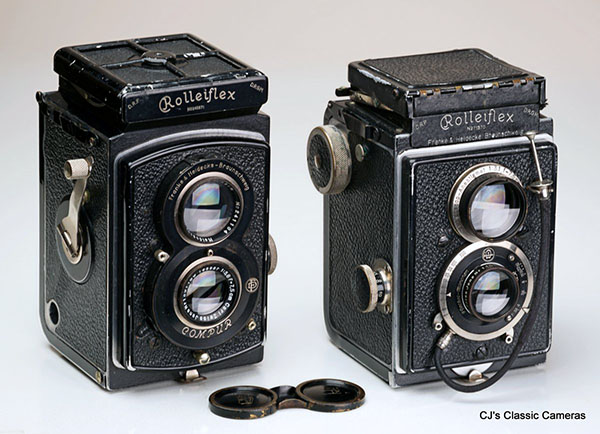
Comparison of the Rolleiflex Standard (left) and the Rolleiflex Original (right). Both examples used the same Tessar f/3.8 lens and Compur shutter.
Rolleiflex 2.8E
I finally succumbed and got a Rolleiflex, just to see how different it is from the Rolleicords I have and if the extra expense is worth it. I'd say probably not, but it is a fantastic camera and I am tempted to keep it (update: or the 3.5F below). After being first introduced in the late 1920s (see 'Rolleiflex Original' above), a number of different Rolleiflex variants were produced, including the 'T' and the 'Automat', but the main production were the 2.8 and 3.5 A-F ranges. The number stood for the taking lens aperture, so the 2.8A would have a Zeiss Tessar f/2.8 lens, whereas the 3.5A would have a f/3.5 lens. They also had slightly different focal lenghts, 80 mm vs. 75mm.

| |
The Rolleiflex 2.8E was introduced in late 1956, so is from about the same time as the Rolleicord Va above. So what are the differences? Well, of course there is the taking lens. The f/2.8 Planar is a five-element lens of great reputation, although of course the four-element Schneider Xenar on the Rolleicord is no slouch. The Rolleiflex was also available with a Schneider lens, the Xenotar, which was similar to the Planar. Coincidentally, the f/3.5 Planar was also a five-element lens, but if the drawing in the instruction manuals are accurate, it had a different design than the f/2.8 version. Both were later replaced with six-element versions, although the exact difference in optical design is debated.
Then there is the light meter. The 2.8E was the first model with an (optional) uncoupled light meter, with the light meter
|
cell mounted below the Rolleiflex nameplate at the front of the camera, whereas the light meter was integrated into the distance knob. It would indicate a light value, which could then be transferred to the exposure system. Of course, another difference is the wind lever, which makes winding the film a lot faster than using the wind knob on the Rolleicord. Another useful feature on the Rolleiflex is the rangefinder prism integrated in the centre of the focussing screen, which makes focussing more accurate, and easier in dim light. Furthermore, the viewfinder has an extra mirror which can be pushed down, which allows focussing and viewing at eye level instead of at waist level.
All in all the Rolleiflex definitely has many advantages over the Rolleicord. If it is worth the 4-8x price depends of course on what you want of the camera. The 3.5 models are somewhere in-between in price, but one could argue that in that case the differences are mostly in camera handling and not so much optical. The good thing is, there is never a bad choice!
A 1959 Rolleiflex 2.8E with Carl Zeiss Planar 80mm f/2.8 taking lens in Synchro-Compur shutter and a Heidosmat taking lens of identical speed and focal length, from three different angles. This is the version with light meter. The 2.8E was the first model with a 35mm frame counter (top right behind the focus knob) for use with a 35mm adapter, which was dropped again on later models.

Rolleicord Va and Rolleiflex 2.8E next to each other.
Rolleiflex 3.5F
Much what I said above about the Rolleiflex 2.8E applies to the 3.5F, but it had several important improvements. First of all, it came with a (still optional) coupled lightmeter, so one would adjust the exposure by changing aperture or shutter speed until the lightmeter indicator would match the needle. Second, it had an interchangeable viewing hood, which could be taken off very easily by pressing two push buttons, and allowed a eye-level prism to be mounted. It must be noted that this lead to a size difference of the frosted screen, so one cannot swap the one in a 3.5F (or 2.8F) with previous models or vice versa.
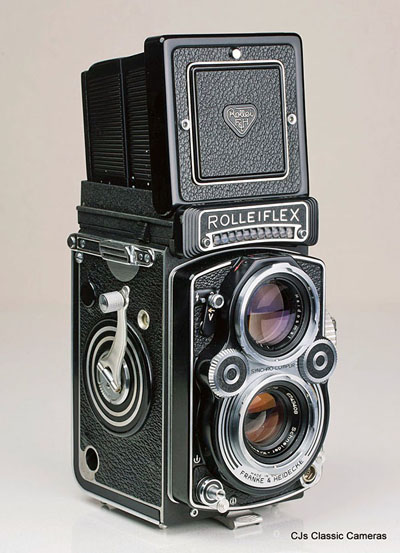
| |
A 1961 Rolleiflex 3.5F Model 3 with Schneider Xenotar 75mm f/3.5 taking lens in Synchro-Compur shutter. The question which was the best lens, the Xenotar or Planar, has led to heated discussions on the internet without a clear winner. I'd say the difference was probably small and nowadays depends more on how well the lens and camera have been treated and serviced than on any perceived original difference in quality.
|
The 3.5F and the 2.8F where the final 'classic' models in the Rolleiflex range, so what happened next? Well, first of all these models stayed in production till 1979. After that the company went through a financial rough patch, but started building TLRs again in 1987 with the introduction of the 2.8GX, which featured TTL (through the lens) metering. Early this century it introduced new wide angle and telelens models, the 4/0 FW and FT, respectively. The company changed owners and name a few times, but still exists as Rollei and is still in German hands, although unrelated to the original Franke & Heidecke company. However, it appears any TLR production seized following the last take-over in 2014.
|
A better view of the controls of the Rolleiflex 3.5F, showing the coupled lightmeter unit integrated into the focus knob as well as the aperture and shutter speed read-outs on top of the viewing lens. Note that the viewing lens had a f/2.8 aperture, so there was no difference in viewing screen brightness between the 3.5 and 2.8 models.
| |
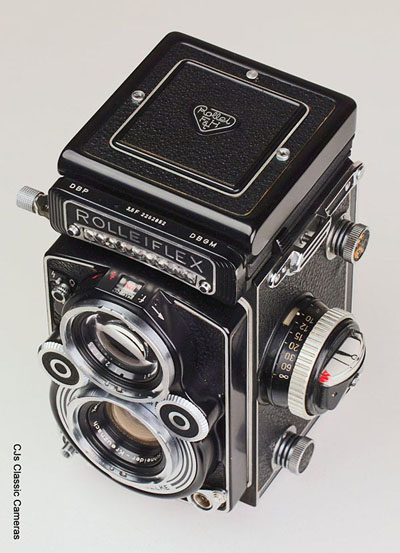
|
Foth-Flex
The Foth-Flex was a rather unusual TLR camera, as it had a focal plane shutter, the only one to do so on this page. When the camera was introduced in 1935 this was probably not considered that unusual; after all there weren't that many TLRs around, and large press cameras with waist-level viewing hoods generally also had focal plane shutters. But the concept did not really catch on for TLRs, perhaps due to the dominance of the Rolleiflex design, or perhaps because leaf shutter were more reliable at the time. Interestingly, focal plane shutters did make a comeback with the Hasselblad-style SLRs in the 1960s, before most of these also changed to leaf shutters.
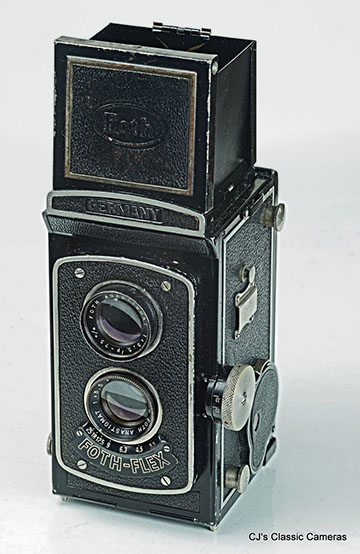 |
|
In any case, the Foth-Flex was made by Foth, who also made the Foth Derby found elsewhere on this side. The Foth-Flex was available with f/3.5 or f/2.5 lens, the latter was probably the fastest medium-format TLR at the time. Early production had a focus lever at the edge of the base board, but later it moved to a more traditional location at the side of the camera. The focal plane shutter had a top speed of 1/500 s and a slow speed setting as well as a self-timer. It also had an automatic film counter, but shutter and film did need to be wound separately. All in all a camera with impressive specs for that era.
A Foth-Flex with Foth Anastigmat 75mm f/3.5 taking lens. At the side of the camera one can find the focus knob, the frame counter unit (bottom left corner) as well as a small plate that looks like an accessory shoe but it's a non-standard type.
|
Foth-flex cameras often don't work these days, as even the best focal plane shutters needs occasional maintenance and don't like sitting around unused for decades. However, the Foth Flex shutter is pretty easy to work on so worth trying to get back to working order. After removing the lever on the side (see photos below and a cover plate at the back, the whole shutter can be removed as a single module. This makes it easy to clean, test and lubricate. Even replacing shutter curtains is fairly straightforward, although don't repeat the atrocious attempt with wrongly-sized blue transparent canvas I received one of mine with!
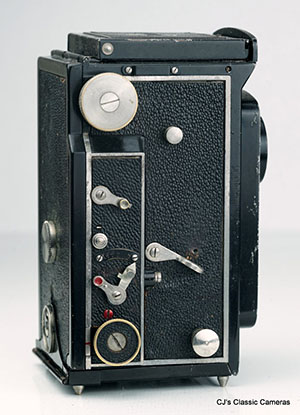

(left) One thing that may put people off from trying the Foth-Flex is that daunting amount of levers and buttons on the side. So here we go: the large top one is to wind the shutter. The smaller one just below it is for a strap. The large lever in the middle is the shutter release, it's facing down here as it got stuck whilst firing the shutter and needs fixing (again), the button in the right bottom corner is the one holding the film spool. At the top of the rectangular area beneath the large wind knob with have from top to bottom the self-timer lever, the button activating said lever (no need to use the shutter release), a slow speed lever in two parts: an arrow indicating the speed and a lever to activate the slow speed mechanism, and finally at the bottom the shutter speed control - it can be lifted and turned to the desired shutter speed. Simples!
(right) Front of the camera, showing amongst others the aperture scale. The aperture is controlled by turning the front part of the taking lens.

| |
As a bonus, a detail of the focus mechanism of the Foth Flex. Underneath the long black vertical bar is a rack that connects the windknob movement to the gears around the lenses. The lenses don't rotate when focussing, as they have a helical focus mount, so only the mount rotates and the lenses move back and forth. Quite a few gears and a rail in the mechanism, so if it feels stiff it's worth taking apart to clean and regrease, including the gear connected to the focus knob that drives the focussing rack.
|
Echoflex Semi-Automat
The popularity of the Rolleis resulted of course in a great variety of copies being made. One of those was the Echoflex, which was a Japanese Rolleicord copy from ca. 1955, which is around the time the Rolleicord IV was in production. As is the case for many Japanese cameras (and lenses), it is not always easy to find out which company made what, as many cameras were rebranded under various names or build to order by a different factory than the company that sold it. The Echoflex is no different. There were two different models, most likely made by different companies, the first one a manual model, the second a semi-automatic model, i.e., with an automatic wind stop (no red window) but not with a self-cocking shutter. The second model is shown here and was purportedly made by Lustre, as the accessory shoe on some examples (including mine) show the letters LKK, from Lustre Koki Kogaku. The manual indicates 'Transvision Trading Co. Ltd., Tokyo Japan' as the sole distributor for the Echoflex.
 |
|
A Lustre Echoflex Semi-Automat with coated 75mm f/3.5 Echor Anastigmat lens in Synchro-Super shutter, which is similar to the Prontor-SV. Comparing it to the Rolleicord IIe above you won't spot many differences, except for the shutter release and aperture and shutter speed controls. |
Lustre also made the Lustreflex, some versions of which did look virtually identical to the Echoflex, but were equipped with Tri-Lausar lenses and Chy-FB shutters instead. Then there was the identical Chelicoflex, which also has an Echor lens and Synchro-Super shutter, and even matching serial number ranges. Then there was the Beautycord, some version of which are identical to the Echoflex and had Tri-Lausar lenses and Synchro-Super shutters. The confusing thing is that the Beautycord was made by Taiyodo Koki, not Lustre, and they made a whole series of other copies, like the Wardflex, Gen-Flex, Photoflex and Fodorflex.
 |
It did not stop there. Next I found a Toyocaflex, made by Tougodo. Again, nearly identical to the Echoflex, although now I managed to find a few small differences: the strap lugs, the position of the flash sync, the film speed dial integrated in the wind knob. Other than that, all controls look the same and work the same. Again, many variants including the Hacoflex, Crownflex, and so on. By that time I gave up! There must be at least 20-30 nearly identical cameras made by at least three different companies within a span of five years or so.
I could only find a poor resolution scan of the manual online, so I made an exact copy of it (including typos!) using my own photos. You can be find it here. |
Richter Reflecta
The Richter Reflecta was a TLR camera initially developed by Merkel (from the Metharette, see elsewhere on this page), which company was taken over by the Richter family in the early 1930s. It was a simple camera, but remember, these were the early days of TLRs and the Reflecta had several interesting features, including a helical focus mount on which both the taking and viewing lens were fixed, and which had a focus lever at the bottom of the shutter. This design was later adapted in modified form by Minolta and Flexaret TLRs. The film-loading assembly had to be taken out of the back of the camera for film loading, unusual for a TLR camera but similar to many box cameras at the time.
The Reflecta later changed its name to Reflekta (and the company to Tharandt). Around 1950 the company was taken over by Welta, who updated the camera to the Reflekta II,
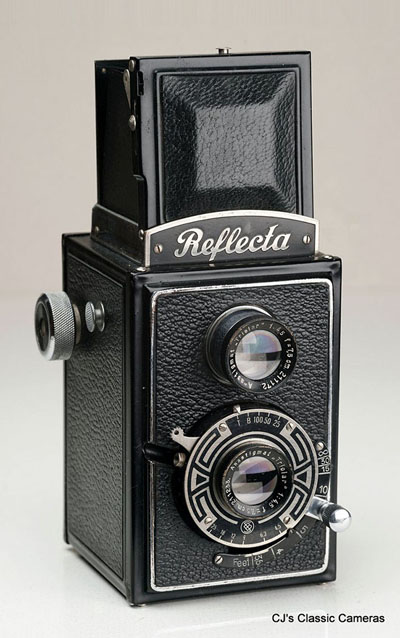
| |
still without much actual change other than a double-exposure prevention, and eventually replaced it in 1955 with the Weltaflex, which did away with the focus lever. It longevity was a clear testament to the quality of its original design.
A Richter Reflecta with Anastigmat "Triolar" 75mm f/4.5 lens in unspecified Art Deco style shutter. I tried to figure out what the shutter was and which company made it, but without much luck. There is a small logo that looks like the letters SB (or BS) . The shutter looks a lot like the Stelo shutters found on the other Reflecta examples, but those have the GW logo from the Gebr Werner (incidentally based in Tharandt, just like the Richter company). UPDATE: Someone got in touch to tell me the shutter was made by Stein & Binneweg in Freital, a small company that made shutters from the mid 1920 to mid 50s. Bedankt Norman!
|
Montanus Rocca Super Reflex
Montanus is probably not a company you will have heard of. It was a plastics manufacturer based in Solingen, former West Germany, which also produced a range of cameras in the 1950s. Their first TLR was the rather unremarkable 1952 Plascaflex, a camera with bakelite body and no outstanding features, not unlike the Argoflex above in fact. Therefore, it is a bit of a surprise that not long after, Montanus came out with the Rocca Automatic and Super Reflex, rather modern looking TLRs with several impressive features better known from the Rolleiflex line, including a film advance crank for automatic film transport, automatic shutter cocking, removable viewing hood and fast f/2.8 lenses. Admittedly, it did not have the build quality of the Rolleiflex and the taking lens was a triplet, not the magnificent Planar or Xenotar, but nevertheless, this was essentially a poor man's Rollei. I haven't found much price information, but in the USA it was for sale in 1956 for $100 (rather curiously, rebranded as Edixa 6x6 and sold by Wirgin), about a quarter of what a Rolleiflex would have cost, and still cheaper than a Rolleicord. It appears though, that these cameras did not sell that well, probably not helped by the manufacturer having little reputation in the camera market, and these TLRs are rare to find these days.
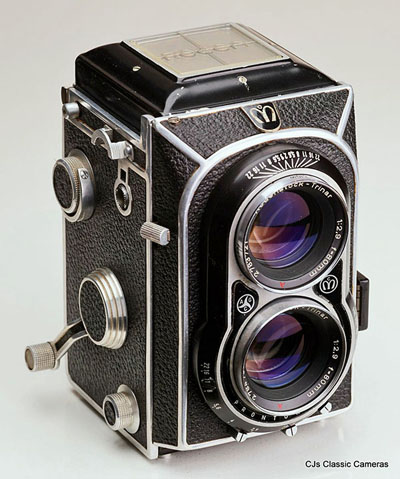 |
|
A Montanus Rocca Super Reflex with two Rodenstock Trinar 80mm f/2.8 lenses. Focussing was done with a slider with a fold-up handle (just visible to the right of the taking lens), which allowed for a fast focus action. |
Lipca Rollop 2.8 Automatic
After coming into possession of the above Montanus Rocca Super Reflex with f/2.8 lenses I started wondering how many other TLRs had similarly fast lenses, as before I had only been aware of the Rolleiflex 2.8 and Mamiya C range. Lo and behold, I came across a Rollop 2.8 by Lipca. Again, a fairly unknown camera maker, although arguably a little better known than Montanus. Lipca was founded just after WWII in Barntrup, West Germany, and traces its origins to Kamera-Werk Richter Tharand, which took over Merkel, the company behind the Reflecta TLR. Lipca only build TLR cameras, first the Flexo and Flexora, later the Rollop I, II and Automatic, which were all fairly successful. The Rollop II was the first Lipca TLR to feature a wind crank, whereas on the Rollop Automatic this crank did not just transport the film but also cocked the shutter (hence the name). The camera did not have a lightmeter, but did have LV markings on its shutter and the exposure could be locked to a set LV value
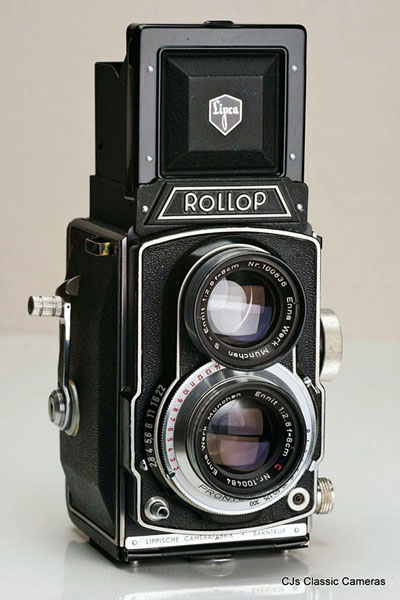 |
by a little switch, so that changing the shutter speed would also change the aperture and vice versa. Arguable the most exciting feature of the Automatic was the four-element Enna Ennit 80mm f/2.8 lens, a lens also found on other highly-rated cameras such as the Balda Super Baldax, and in terms of quality somewhere in-between the Planar and Xenotar on the Rolleis on the one hand and the Trinar on the Rocca Super Reflex above on the other hand. It was produced from 1956 to 1961.
Early version of the Lipca Rollop 2.8 Automatic with two four-element Enna Ennit 80mm f/2.8 lenses. This version did not yet have the name 'Automatic' beneath its name badge. It is also missing the accessory shoe and shutter release lock found on later production.
|

Several more views of the Lipca Rollop 2.8 Automatic.
Lipca Flexora
The Lipca Flexora was a much simpler camera than the Rollop from the same company (see above). Due to the name and the fact it has a focussing lever at the bottom of the camera, I initially thought it was made by Meopta (see Flexaret below). It had a wind knob and the traditional red window for film advance, with no double exposure prevention.
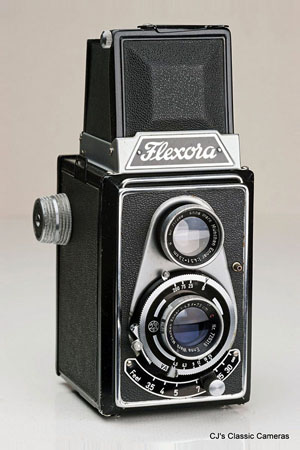
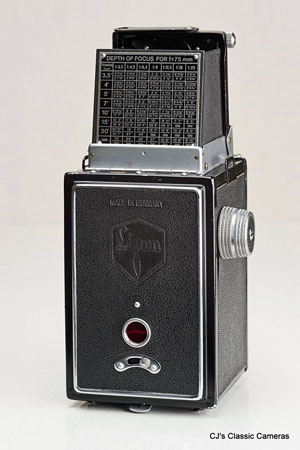
A Lipca Flexora with Enna Ennar 75mm f/4.5 lens in Vario shutter. The three-speed shutter is nothing special, but the Enna lenses had a good reputation - the same lens can also be found on the Balda Mess Baldix. Note the metal bar just beneath the Flexora name plate, this was actually the top part of a frame finder which could be pulled up.
Meopta Flexaret IVa
Meopta is not a brand I know much about but it is actually a company that still exists. It is an optical company that was founded in former Czechoslovakia in the 1930s which made several high-quality camera lines, including Leica style rangefinders (the Opema), large format technical cameras and a range of TLRs, the Flexaret, as well as photo enlargers. One of the interesting features of the Flexarets was that many of the models were designed to be quite adaptable in terms of film type or frame size. The Flexaret IVa is a good example of that.

| |
It was introduced in 1956 and has a film transport feeler spool that also had sprocket wheels for 35mm film, which would give telephoto shots in portrait mode. The film counter could be adjusted to 35mm film also, albeit it manually. Unfortunately, this was all a little confusing if one used the camera in its regular 6x6 120 film mode. As Meopta was first and foremost an optical company, its cameras were equipped with its own lenses, which have a great reputation.
(left) A Meopta Flexaret IVa with coated four-element Belar 80mm f/3.5 lens in Prontor-SVS shutter. The small silver insert in the viewing hood with the Meopta logo can be folded away, which turns the hood into a 35mm direct viewfinder.
|
Another interesting feature was the focus mechanism, which consisted of a lever beneath the lens which would turn the focus helicoid on which the viewing and taking lens were mounted. This is similar to the mechanism on most Minolta TLRs, but Meopta introduced it earlier, although they did not invent it, as a similar construction can be found on older TLRs such as the Richter Reflecta.
|
The construction of the Flexaret was quite different from most other TLRs - it came apart in two main pieces: the film compartment with wind mechanism and the lens board-focus mechanism-viewing hood. With most other TLRs you can remove the viewing hood separately but access to the focus mechanism is often difficult.
| |
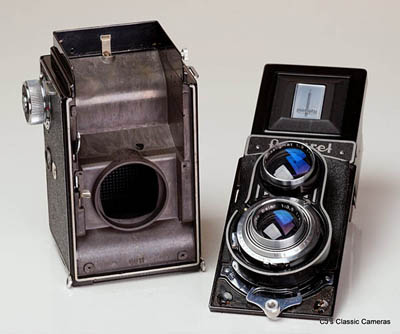
|
Ricohmatic 225
The Riken Ricohmatic 225 was one of several TLR cameras made by Riken, and a surprisingly good performer considering it is not very well known. It was well-build and featured a wind lever with automatic film transport and shutter cocking, an uncoupled lightmeter and a very smooth focussing system with a lever along the right side of the camera. A needle showed the focus distance on a scale beneath the lens board. A bit of a gimmick was the rewind lever for 35mm film, for which there was an adapter kit. Interestingly, film transport was from top to bottom, which may have the advantage that the film only bends after exposure, improving film flatness especially if the camera had been sitting with film loaded for a while.
I have a few other cameras from the Ricoh brand, which can be found here.

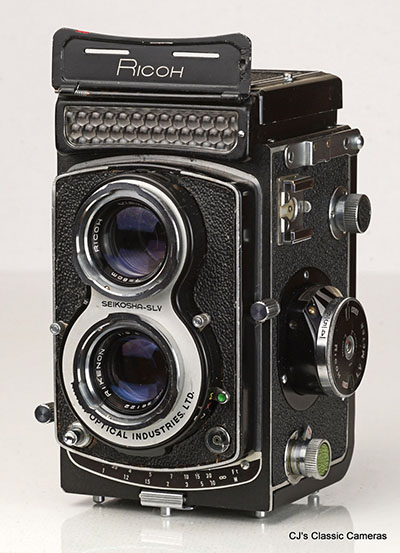
A Riken Ricohmatic 225 with Ricoh 80 mm f/3.5 lens in Seikosha-SLV shutter. The lightmeter cell was hidden behind a flap, just like on the Minolta Autocord LM, but Ricoh clearly didn't want to leave any doubt it was their camera, so they printed their name on the inside of the flap also.
Yashica-D
Besides producing rangefinders and half frame cameras that you can find elsewhere on this site, Yashica had a great reputation as a maker of TLR cameras. However, there's such a large range of them that I've always been somewhat reluctant to look at them closely, until one showed up on my doorstep as a repair job: the Yashica-D below.
It appears that TLRs were in fact the first type of cameras made by Yashica, starting in 1953 with the Yashimaflex, soon after to be followed by the Yashicaflex, which was available in quite a few variants, such as the Yashicaflex A, B, C, S and AS. These were all knob-wind TLRs, so more comparable to Rolleicord than to the Rolleiflex, but it is interesting to point out that some of these were equipped with light meters. At some point around 1957 or 1958 (even the experts disagree) the Yashica A, B, C and D were introduced. These all had the same lenses but the higher 'letters' had better shutters and some additional features. Then there were the Yashica 635 and LM, which were a D with 35mm option and C with light meter, respectively. If you are starting to get confused, so am I!
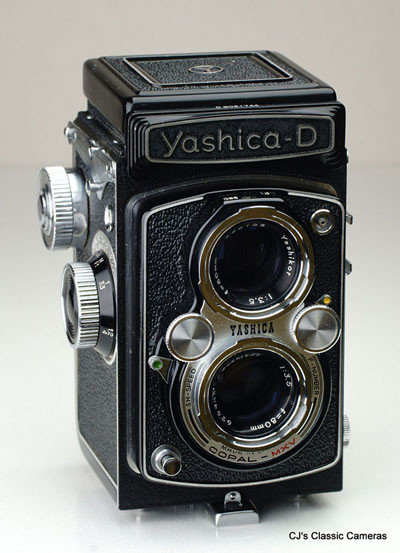
| |
A Yashica-D with Yashikor 80mm f/3.5 lens in Copal MXV shutter from around 1969. In addition to making many models, Yashica also kept building them all for a long time. The Yashica-D had a life span of no less than 14 years!
This example had a sticky shutter with greasy blades but was other than that in great condition, as the picture shows.
|
Of course it didn't stop here. Soon followed the Yashica-Mat with wind crank, also available in LM and EM versions, the fully automatic Yashica E, then the Yashica 24, 12, both replaced by the Yashica Mat-124 (we're in the late 60s now) and the final model, the 124G. If you're getting cranky, so am I (pun intended).
All the mumbo jumbo aside, Yashica build their TLRs in large numbers as they were well-featured with highly respected lenses for a reasonable price. Perhaps they weren't as robust as the Rolleis, but good enough for amateur enthusiast, i.e., the people who could afford these, but not the Rolleis.
The Yashica-D is a good example. First of all, it looks like a Rollei, it has the same bayonet filter mount and similar shutter controls, the materials look of good quality, in fact it comes across as a Rolleiflex, just with knob wind, and it certainly compares well with the Rolleicord Va from the same time. All in all, the same counts today as all those years ago, if you want a TLR that does the job but doesn't break the bank, try a Yashica! If you want to know more, check out the Yashica TLR site, which has a dazzling amount of detailed information.
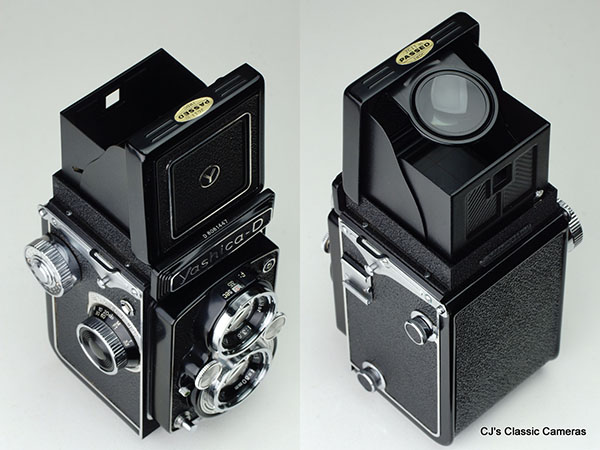
Two top views of the Yashica-D. All rather familiar looking, but that's a good thing in this case.
Yashica-E
The Yashica-E is a rare unique TLR, as it's one of the very few that had a lightmeter unit around it taking lens (the E in Yashica-E probably stood for 'electronic eye'). At the time, this was quite a popular arrangement for 35mm cameras, including for example the Yashica Mimy, as the lightmeter reading and thus exposure were automatically corrected when a filter was attached. However, I can't remember seeing it on any other TLR cameras. They didn't often come with lightmeters anyway, and if they did they were usually mounted at the front just below the viewing hood, see e.g., Rolleiflex 3.5F, Minolta Autocord LM or indeed Yashica's own 44 LM elsewhere on this page. Not only did the Yashica-E have a lightmeter, it also had a fully automatic exposure system, albeit with a fixed shutter speed of 1/60 s. But this was as close to a point and shoot TLR as one could get. One could still set the aperture manually if needed.
The Yashica-E had another quite unique feature and that was a build-in flash unit. It was hidden behind the name plate, so not immediately obvious. One would need to insert a flash bulb for each flash exposure. Yashica acknowledged that this build-in flash was only of use for easy lighting circumstances by still supplying a connector for an external, more powerful flash unit. To use the build-in flash one had to read off the aperture value on the flash guide at the back of the camera, taking into account subject distance and film speed.

| | |
The fully automatic exposure Yashica-E with Yashinon 80mm f/3.5 taking lens. It has a exposure warning indicator next to the viewing lens, which would indicate if the scene was too dark, in which case one would need to use the flash, or too bright, in which case one would need to mount a neutral density filter on the lens.
|
Yashica 44 / 44 LM
The Yashica 44 was, as the name implies, a TLR with a 4x4 cm film frame to be used with 127 rollfilm. There were three main versions, one lever wind and two knob wind models, one of which had an uncoupled selenium cell lightmeter, the 44 LM. The 44LM had aperture and shutter speed setting knobs similar to the Yashica-D above, and an automatic wind mechanism, in contrast to the regular wind knob model (the 44A), which had a manual wind mechanism, i.e., was controlled using a red window and had no frame counter. In contrast to knob wind 6x6 models, which have both focus and wind knob on the same side of the camera, the Yashica 44A and 44 LM had wind and focus knobs on opposite sides of the camera. The Yashica 44s were available in a wide range of colours, including unusual funky ones such as red, brown and blue, although the choice for the 44 LM was limited to only three. The Charcoal Gray one shown below is in my experience the most common, at least in the UK.
 |
|
A funky-looking Yashica 44 LM with 60mm f/3.5 Yashinon, a coated triplet lens. This example is from April 1960 (as the serial# starts with 64). Not visible is the large wind knob with integrated lightmeter controls. On the back of the camera is a red window, which is only necessary to wind the film to the first frame.
|
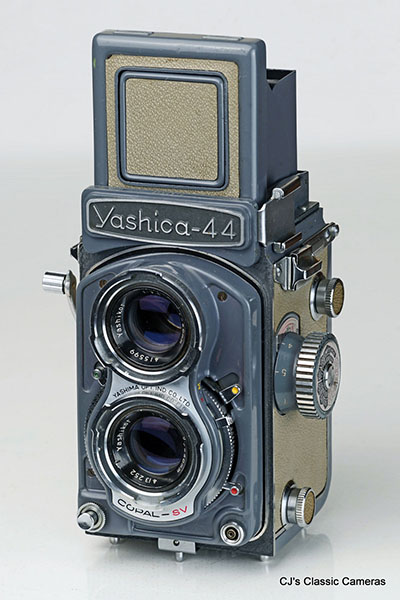
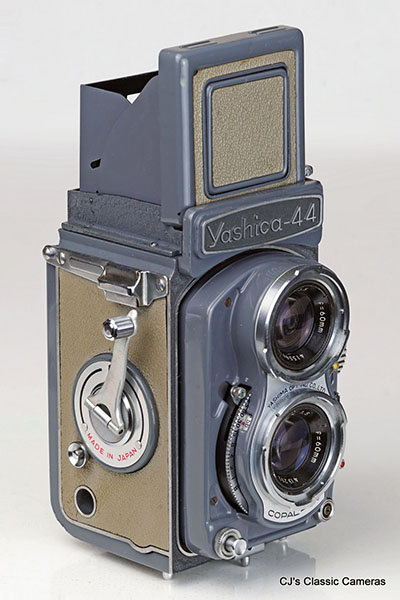
And here is a regular Yashica 44, which was equipped with a 60mm f/3.5 Yashikor lens and had a wind lever in contrast to the knob wind 44 LM and 44A models. The aperture and speed controls are different as well: where the LM had Rolleiflex style dials, the 44 had simpler levered adjusters on the shutter itself. Note that this example is missing the leather trim on the front plate.
Walz Automat 44
I finally got my hands on a 4x4 TLR with f/2.8 lens, which I had been looking for for a while (update: I wrote this before getting the Yashica 44 above). Walz was one of the lesser-known Japanese camera companies and it made only a small range of cameras, but they were well-made and had an excellent reputation. This also applied to their Automat 44, a 4x4 TLR for 127 film. Although it looked like a copy of the Baby Rolleiflex, including the grey colour scheme, there were some important differences. First of all, it had a wind lever, where the Baby Rolleiflex (somewhat surprisingly) had a wind knob. In addition, the Walz had a focussing lever beneath the lens board, like the Meopta Flexaret and Minolta Autocord, whereas the Baby Rollei had a focus knob on the side. Finally, the Walz had shutter speed and aperture setting dials typical of the Rolleiflex range, but lacking on the Baby Rollei. All of which begs the question, was the Baby Rolleiflex really a Baby Rolleicord, but that's a different topic.
Another interesting feature of the Walz were its lenses, which were made by the small but legendary lens maker Zunow Optical. In 1951 Zunow introduced a 50mm f/1.1 lens for Leica and Nikon rangefinders, at the time the fastest lens available. They also made lenses for various Japanese camera makers such as Miranda, Neoca and indeed Walz. The lens on the Walz appears to be a four-element lens.
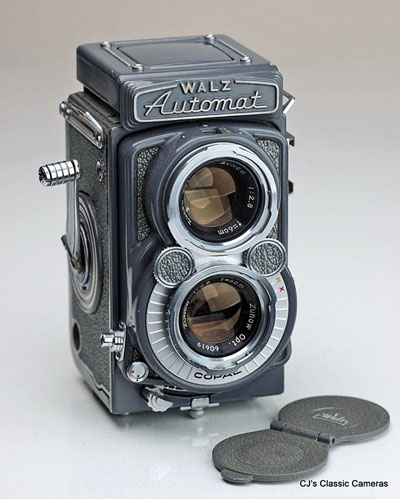 |
|
A Walz Automat 44 with Zunow 60mm f/2.8 lens in Copal shutter. The camera had a wind lever that would transport the film and cock the shutter, but my example does not stop automatically so you need to watch the frame counter whilst winding. I can't find a manual so I am not sure if this is a feature or a fault. |
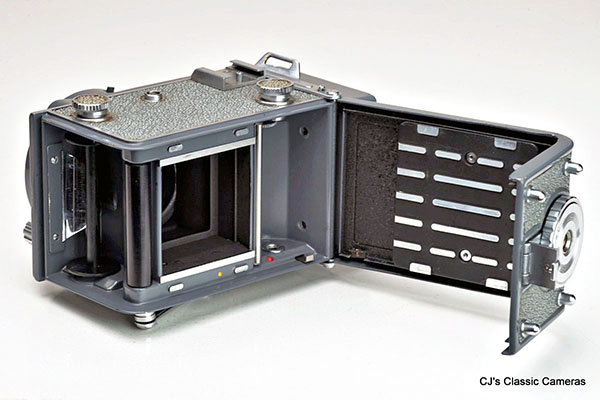
Rear-view of the Walz Automat 44 with the back open. The yellow dot is probably for film-loading but I am not sure about the meaning of the red one. Perhaps just to indicate where the film goes. Note that the film moves from top to bottom, the opposite of most other TLRs.
Argus Argoflex EM
Argus was an American camera company that produced its own cameras as well as licensed cameras build by other companies (e.g., the Argus V-100 by Iloca). Its most famous cameras were the Argus A and Argus C ranges (latter a.k.a. 'the Brick'), which made 35mm photography affordable nearly for everyone.
The TLR cameras made by Argus, the Argoflex range, are relatively unknown, certainly on this (non-US) side of the Atlantic and I only got one by accident in a lot with other cameras. The Argoflex E series, which my example is part of, differed considerably from the Rolleicords above, as the Argoflex took 620 roll film, had a front cell focussing taking lens which was coupled to the viewing lens by a gear system and had a self-cocking shutter. It did not have a wind lock mechanism so film winding had to be monitored using the customary 'red window'. The frosted focussing screen was a little smaller than the 6x6 Rolleicord ones, but did include a magnifier and sports finder. Only a few models were produced, the earliest had a plastic body, later models had metal bodies and the last version, the EF, had a flash sync with accessory shoe at the side of the body.
Later Argoflex models had plastic bodies but were pseudo-TLRs, lacking focus-coupling of the taking lens.
 |
|
An Argoflex EF from the late 1940s with coated 75mm f/4.5 Varex lens. |
|

